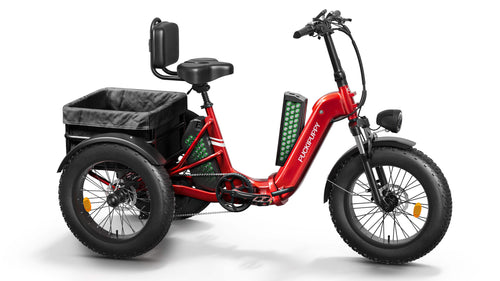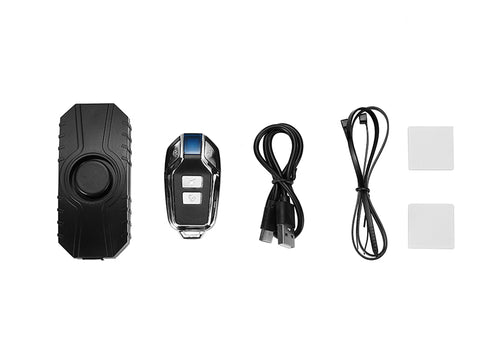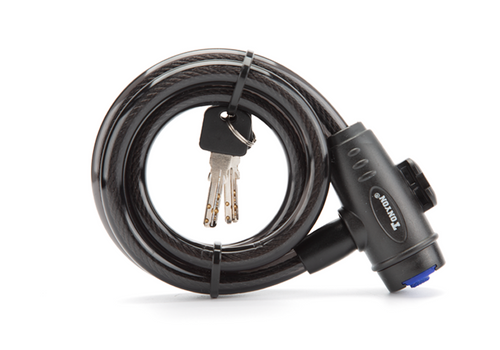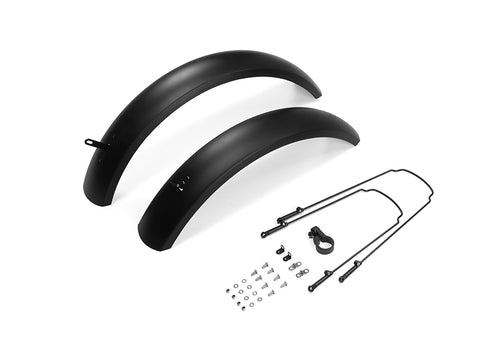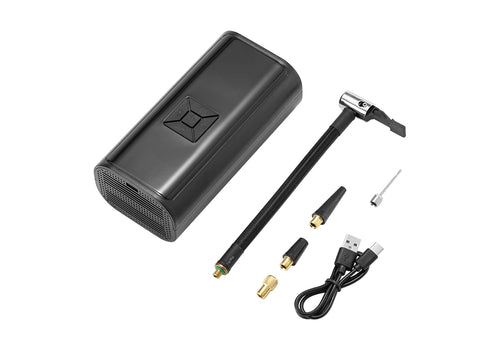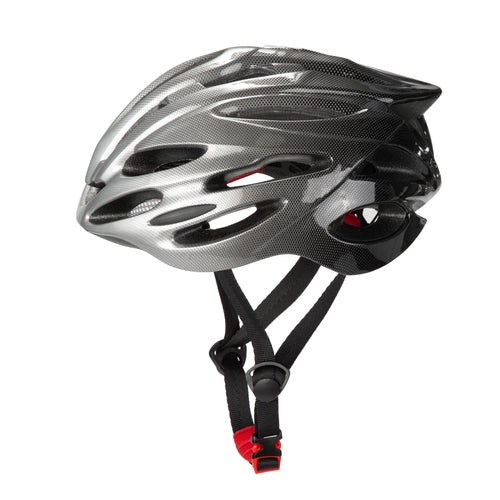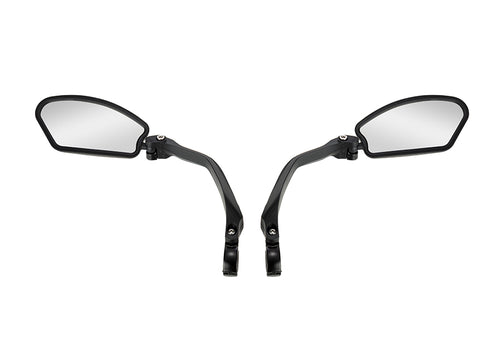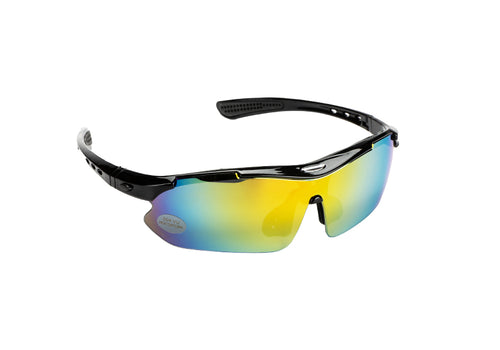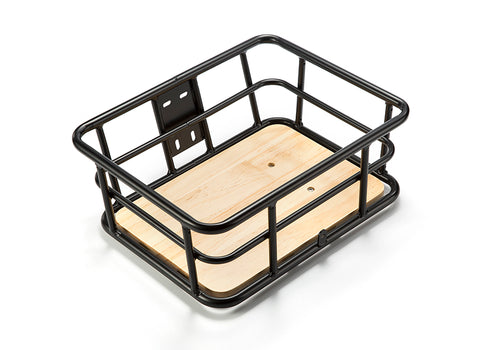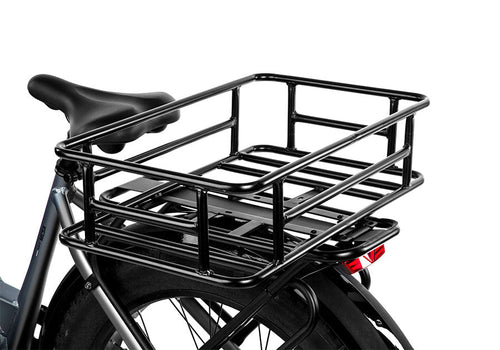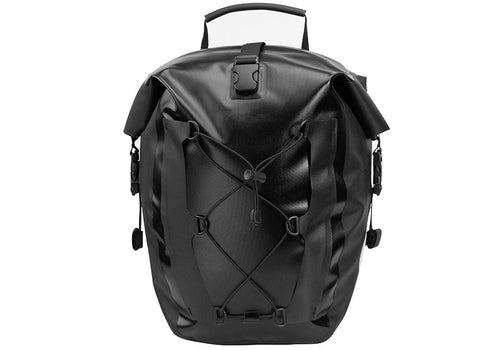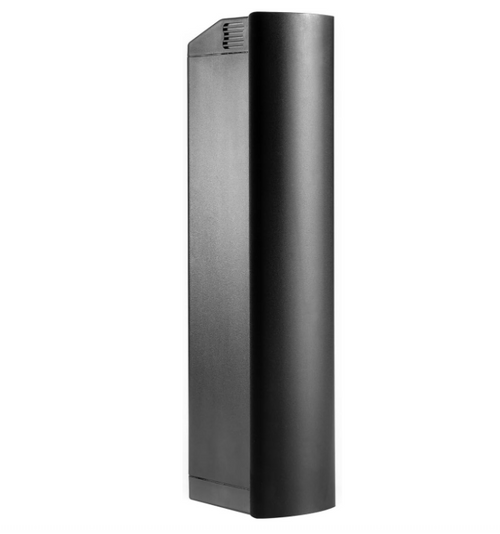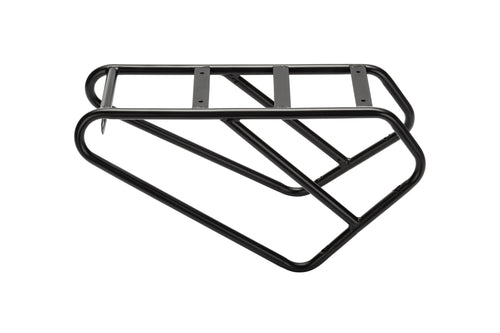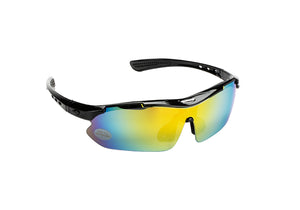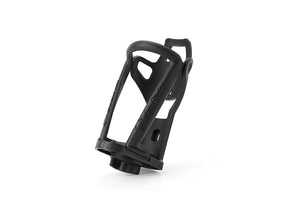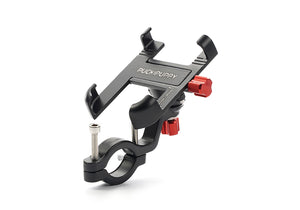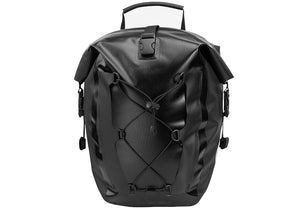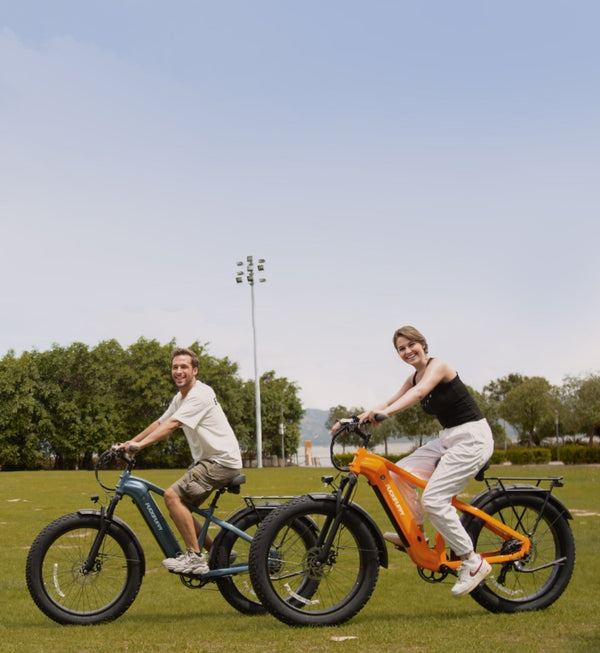
Blog
All the riding-related information you are interested in is here.

Best Black Friday and Cyber Monday eBike Deals: Up to $1,000
As Black Friday and Cyber Monday approach, Puckipuppy’s premium electric bikes are available at the lowest prices of the year. Whether you’re looking for a commuter e-bike, an off-road model, or an electric tricycle, Puckipuppy has a variety of deals with added incentives, such as free racks, bonus batteries, and exclusive accessory packs. With discounts up to $1,000 off, don’t miss your chance to invest in a high-quality e-bike this Black Friday! Below are our best BFCM offers and you can take advantage of these deals before they’re gone. Buy 2 E-Bikes, Get a Free Rack For anyone purchasing two e-bikes, we offer a free rack valued at $499, perfect for transporting your new bikes. This deal adds significant value, especially for those who travel frequently and need a reliable way to carry their e-bikes securely. Free $499 Battery or Deluxe Accessory Pack Buying any e-bike this Black Friday also entitles you to a free battery or a deluxe accessory pack, while supplies last. The extra battery is an ideal choice for those who want to maximize their bike’s range and it also significantly enhances your riding experience. If you opt for the deluxe accessory pack, you’ll get practical enhancements tailored to improve both safety and convenience on the road. Extra Special Gift Pack For every purchase this season, we are including an additional gift pack. This pack varies according to the bike’s purpose—commuter, off-road, or all-terrain—and contains select items that complement the bike model. This offer adds even more value, making it an opportune time to secure these extras while supplies last. Best Commuter Electric Bike Black Friday Deals Beagle Orange Sale Price: $1,049.99 (Save $750) The Beagle e-bike is an excellent commuter choice, featuring a 48V 15Ah battery that delivers up to 60 miles on a single charge. Built from durable 6061 aluminum alloy and with a 400 lbs payload capacity, it’s lightweight and easy to handle for daily use and able to carry heavy cargo, catering to raiders’ versatile needs. With wire pull disc brakes, the Beagle provides a safe and smooth commute even in crowded urban areas. This bike combines stability, style, and ease of handling, making it a great investment for city commuters who want an efficient and sustainable way to get around. Samoyed BFCM Flash Sale Price: $1,099.99 (Save $600) For riders who prefer a step-thru design, the Samoyed offers extra convenience and a comfortable ride. This model also boasts a 60-mile range and includes wire pull disc brakes for a responsive stopping experience. With compact 26" tires, the Samoyed is well-suited for navigating busy streets and tighter spaces. The step-through frame provides extra convenience, particularly for those with limited mobility or those who frequently get on and off their bike. Its 350 lbs payload capacity is suitable for most people’s needs. Best Off-Road Electric Bike Black Friday Deals Labrador BFCM Flash Sale Price: $1,399.99 (Save $1,000) The Labrador is designed for those who love trail riding or need a durable e-bike for rugged conditions. With a 48V 20Ah battery that provides an impressive 80 miles range, this model is well-equipped for off-road journeys. Its wide 26" x 4" fat tires give the bike extra stability and grip on uneven ground, and the adjustable suspension ensures a smooth ride on rough trails. With its 400 lbs payload capacity, the Labrador caters to versatile needs, whether it’s for running daily errands or going grocery shopping. Additionally, the hydraulic disc brakes offer superior control on steep descents, making the Labrador a solid choice for mountain bike Black Friday deals. Boxer BFCM Flash Sale Price: $1,399.99 (Save $900) The Boxer offers equally powerful specs as the Labrador, with a 960W peak motor and a 48V 20Ah battery that can also reach up to 80 miles on a full charge. Its sturdy 26" x 4" tires, paired with hydraulic disc brakes, make it an excellent choice for riders who want a versatile bike capable of handling both off-road adventures and urban routes. With a 400 lbs payload capacity, it’s an attractive option for those seeking a multi-purpose bike that doesn’t compromise on performance this Black Friday. Best All-Terrain Electric Bike Black Friday Deals Boxer ST BFCM Flash Sale Price: $1,399.99 (Save $900) The Boxer ST is an all-terrain marvel with a step-through frame, designed for riders who commute in the city but also want to venture into the wild. Featuring the same 48V 20Ah battery as its off-road counterparts, it offers up to 80 miles per charge. Boasting a 400 lbs payload capacity, it caters to riders’ versatile needs, such as heavy cargo carrying. With both hydraulic disc brakes and adjustable suspension, this bike is built for stability across various terrains, whether on smooth streets or bumpy trails. This versatile model is a top choice for those looking for mountain bike Black Friday deals. Best Electric Tricycle Black Friday Deals Husky BFCM Flash Sale Price: $1,999.99 (Save $1,000) For those interested in stability and storage capacity, the Husky series electric tricycles are perfect options. The Husky Plus features a dual battery setup, combining a 48V 18Ah battery and a 48V 15Ah battery, giving it a range of up to 110 miles. Both tricycles offer a substantial 500 lbs payload capacity, making them ideal for carrying cargo, groceries, or other heavy loads. With hydraulic disc brakes and stable 20" x 4" tires, the Husky and Husky Plus ensure that riders experience a smooth, secure journey. These models are especially suited for senior riders or those needing extra support, and the Cyber Monday e-bike deals make them even more accessible with the Husky being on sale at $1,999.99 and Husky Plus at $2,299. Get Your Ideal Puckipuppies with Highly-Valued Offers Our Black Friday and Cyber Monday deals offer significant savings across a range of e-bike styles, from commuter-friendly models to off-road and all-terrain bikes. With limited-time discounts and a variety of models to choose from, now is the perfect time to take advantage of these Black Friday bike sales and elevate your cycling experience. Seize the Best E-Bike Deals and take a puppy home today before they’re gone!
Best Black Friday and Cyber Monday eBike Deals: Up to $1,000
As Black Friday and Cyber Monday approach, Puckipuppy’s premium electric bikes are available at the lowest prices of the year. Whether you’re looking for a commuter e-bike, an off-road model, or an electric tricycle, Puckipuppy has a variety of deals with added incentives, such as free racks, bonus batteries, and exclusive accessory packs. With discounts up to $1,000 off, don’t miss your chance to invest in a high-quality e-bike this Black Friday! Below are our best BFCM offers and you can take advantage of these deals before they’re gone. Buy 2 E-Bikes, Get a Free Rack For anyone purchasing two e-bikes, we offer a free rack valued at $499, perfect for transporting your new bikes. This deal adds significant value, especially for those who travel frequently and need a reliable way to carry their e-bikes securely. Free $499 Battery or Deluxe Accessory Pack Buying any e-bike this Black Friday also entitles you to a free battery or a deluxe accessory pack, while supplies last. The extra battery is an ideal choice for those who want to maximize their bike’s range and it also significantly enhances your riding experience. If you opt for the deluxe accessory pack, you’ll get practical enhancements tailored to improve both safety and convenience on the road. Extra Special Gift Pack For every purchase this season, we are including an additional gift pack. This pack varies according to the bike’s purpose—commuter, off-road, or all-terrain—and contains select items that complement the bike model. This offer adds even more value, making it an opportune time to secure these extras while supplies last. Best Commuter Electric Bike Black Friday Deals Beagle Orange Sale Price: $1,049.99 (Save $750) The Beagle e-bike is an excellent commuter choice, featuring a 48V 15Ah battery that delivers up to 60 miles on a single charge. Built from durable 6061 aluminum alloy and with a 400 lbs payload capacity, it’s lightweight and easy to handle for daily use and able to carry heavy cargo, catering to raiders’ versatile needs. With wire pull disc brakes, the Beagle provides a safe and smooth commute even in crowded urban areas. This bike combines stability, style, and ease of handling, making it a great investment for city commuters who want an efficient and sustainable way to get around. Samoyed BFCM Flash Sale Price: $1,099.99 (Save $600) For riders who prefer a step-thru design, the Samoyed offers extra convenience and a comfortable ride. This model also boasts a 60-mile range and includes wire pull disc brakes for a responsive stopping experience. With compact 26" tires, the Samoyed is well-suited for navigating busy streets and tighter spaces. The step-through frame provides extra convenience, particularly for those with limited mobility or those who frequently get on and off their bike. Its 350 lbs payload capacity is suitable for most people’s needs. Best Off-Road Electric Bike Black Friday Deals Labrador BFCM Flash Sale Price: $1,399.99 (Save $1,000) The Labrador is designed for those who love trail riding or need a durable e-bike for rugged conditions. With a 48V 20Ah battery that provides an impressive 80 miles range, this model is well-equipped for off-road journeys. Its wide 26" x 4" fat tires give the bike extra stability and grip on uneven ground, and the adjustable suspension ensures a smooth ride on rough trails. With its 400 lbs payload capacity, the Labrador caters to versatile needs, whether it’s for running daily errands or going grocery shopping. Additionally, the hydraulic disc brakes offer superior control on steep descents, making the Labrador a solid choice for mountain bike Black Friday deals. Boxer BFCM Flash Sale Price: $1,399.99 (Save $900) The Boxer offers equally powerful specs as the Labrador, with a 960W peak motor and a 48V 20Ah battery that can also reach up to 80 miles on a full charge. Its sturdy 26" x 4" tires, paired with hydraulic disc brakes, make it an excellent choice for riders who want a versatile bike capable of handling both off-road adventures and urban routes. With a 400 lbs payload capacity, it’s an attractive option for those seeking a multi-purpose bike that doesn’t compromise on performance this Black Friday. Best All-Terrain Electric Bike Black Friday Deals Boxer ST BFCM Flash Sale Price: $1,399.99 (Save $900) The Boxer ST is an all-terrain marvel with a step-through frame, designed for riders who commute in the city but also want to venture into the wild. Featuring the same 48V 20Ah battery as its off-road counterparts, it offers up to 80 miles per charge. Boasting a 400 lbs payload capacity, it caters to riders’ versatile needs, such as heavy cargo carrying. With both hydraulic disc brakes and adjustable suspension, this bike is built for stability across various terrains, whether on smooth streets or bumpy trails. This versatile model is a top choice for those looking for mountain bike Black Friday deals. Best Electric Tricycle Black Friday Deals Husky BFCM Flash Sale Price: $1,999.99 (Save $1,000) For those interested in stability and storage capacity, the Husky series electric tricycles are perfect options. The Husky Plus features a dual battery setup, combining a 48V 18Ah battery and a 48V 15Ah battery, giving it a range of up to 110 miles. Both tricycles offer a substantial 500 lbs payload capacity, making them ideal for carrying cargo, groceries, or other heavy loads. With hydraulic disc brakes and stable 20" x 4" tires, the Husky and Husky Plus ensure that riders experience a smooth, secure journey. These models are especially suited for senior riders or those needing extra support, and the Cyber Monday e-bike deals make them even more accessible with the Husky being on sale at $1,999.99 and Husky Plus at $2,299. Get Your Ideal Puckipuppies with Highly-Valued Offers Our Black Friday and Cyber Monday deals offer significant savings across a range of e-bike styles, from commuter-friendly models to off-road and all-terrain bikes. With limited-time discounts and a variety of models to choose from, now is the perfect time to take advantage of these Black Friday bike sales and elevate your cycling experience. Seize the Best E-Bike Deals and take a puppy home today before they’re gone!

Ebike Battery Maintenance
Taking care of your e-bike battery isn't just about keeping it charged—it’s about ensuring every ride is safe, powerful, and lasts as long as possible. But have you ever wondered what it would be like to start each day knowing your battery is not only fully charged but also properly maintained and ready to deliver the range and power you need? How would it feel to ride without any concerns about performance or safety? In this guide, we’ll explore essential tips and best practices to help you keep your e-bike battery in top condition, reduce potential risks, and ensure you can enjoy every ride with complete peace of mind. Understanding the Basics of Ebike Battery About Ebike Battery The battery is the powerhouse of your e-bike, providing the necessary energy to propel you through urban streets or scenic trails. Typically, e-bike batteries are composed of several key components, including cells (often Lithium-ion), a Battery Management System (BMS), and a protective casing. These components work together to deliver consistent power while ensuring safety and longevity. Common Battery Types E-bike batteries primarily use Lithium-ion technology due to their superior energy density, lightweight, and long cycle life. Other types, such as Nickel Metal Hydride (NiMH) and Lead-Acid, are less common but still present in some older or budget models. Understanding the specific maintenance needs of your battery type is essential for optimal care. Battery Specifications Puckipuppy ebikes boast advanced Lithium-Ion Batteries, known for their superior energy efficiency, lightweight build, and long-lasting performance. Below is a detailed breakdown of the battery configurations available for the Puckipuppy models: 48V 20Ah: Models: Boxer, Boxer St, Labrador, Corgi, Corgi 2.0 Style: Off-Road E-bikes Ideal for: Long-distance adventures and high-demand usage, providing substantial range and consistent power, perfect for off-road explorations and extended rides. 48V 18Ah + 48V 15Ah (Dual Batteries): Model: Husky Plus Style: Foldable Cargo Trike Ideal for: Ultimate long-range trips, featuring dual battery systems that significantly boost power and extend the ride duration, making it ideal for tackling challenging terrains and ensuring you can go the extra mile. 48V 15Ah: Models: Beagle, Samoyed Style: Commuter E-bikes Ideal for: Everyday commuting and mid-range travel, offering a balanced mix of power and efficiency, suited for city rides and suburban routes. Getting to know these battery specifications provides essential insights into selecting the right power source for your Puckipuppy e-bike, ensuring you enjoy a reliable, powerful, and extended riding experience tailored to your needs. How to Make Your Ebike Battery Last Longer Proper Charging Practices Charging your e-bike battery correctly is one of the most important steps in maintaining its longevity. Always use the charger provided by the manufacturer, as using incompatible chargers can damage the battery. It's best to charge the battery after each ride rather than letting it completely drain. Aim to keep the battery charge between 20% and 80% to avoid deep discharging, which can significantly reduce its lifespan. Avoid Overcharging and Deep Discharging Overcharging can lead to overheating, which in turn damages the cells within the battery. On the other hand, deep discharging, where the battery is completely drained before recharging, can also harm the cells and reduce the overall capacity. Most modern e-bikes come with a BMS that prevents these issues, but it's still good practice to monitor charging sessions. Optimal Riding Conditions Temperature, terrain, and load all play significant roles in how your battery performs. For example, extreme temperatures—both hot and cold—can reduce battery efficiency. Riding on hilly terrain or with heavy loads requires more power, thus draining the battery faster. Whenever possible, ride under moderate conditions and avoid extreme temperatures to preserve battery health. Regular Usage and Maintenance Regularly using your e-bike and performing basic maintenance checks can extend the life of your battery. This includes checking for physical damage, ensuring connectors are clean and secure, and inspecting the battery's charge levels. Additionally, regularly calibrating the battery by allowing it to fully discharge and then fully recharge can help maintain its accuracy and performance. Charging Your Ebike Battery: Best Practices Using the Correct Charger Always use the charger that is specifically designed for your Puckipuppy e-bike’s battery. Using a charger with a different voltage or amperage can damage the battery and void the warranty. If you need a replacement charger, purchase it directly from our online store or a trusted retailer. Charging in Optimal Conditions Charge your e-bike battery in a cool, dry place away from direct sunlight. Extreme temperatures can affect the charging process and the overall health of the battery. Ideally, charge the battery indoors where the temperature is stable. Troubleshooting: Why is My Ebike Battery Draining So Fast? Common Causes of Fast Battery Drain If you notice that your e-bike battery is draining faster than usual, several factors could be at play. Extreme temperatures, frequent use of high power modes, and old or damaged batteries are common culprits. Riding habits, such as frequent stops and starts, can also contribute to faster battery drain. Solutions and Preventive Measures To prevent rapid battery drain, adjust your riding habits by using lower power modes when possible and avoiding extreme temperatures. Regularly check the battery for signs of wear and tear, and consider replacing it if it’s nearing the end of its life. Choosing the Right Ebike Battery Accessories for Maintenance Essential Tools and Accessories Maintaining your e-bike battery is easier with the right tools. Essential accessories include voltmeters for checking battery voltage, battery testers, and protective cases to safeguard against physical damage. These tools can help you monitor the health of your battery and prolong its lifespan. Recommended Products from Our Store For those looking to enhance their e-bike battery maintenance, we offer a range of products designed to help. Explore our premium chargers, durable protective covers, and reliable replacement batteries—accessories crafted to enhance your e-bike experience and ensure smooth operation for years to come. FAQs 1. How Often Should I Charge My E-bike Battery? Charge your e-bike battery after each ride if possible. Regular charging helps maintain battery health and prevents deep discharging. 2. Can I Leave My E-bike Battery Charging Overnight? Yes, you can leave it charging overnight, but it’s best to use a charger with an automatic shutoff feature to prevent overcharging. 3. What Is The Best Way to Store My E-bike Battery When Not in Use? Store the battery in a cool, dry place with a charge level between 50% and 80%. Avoid storing it in extreme temperatures. 4. How Can I Tell If My E-bike Battery Is Failing? Signs of a failing battery include decreased range, slower charging times, and the battery not holding a charge. 5. What Should I Do If My Battery Gets Wet? If your battery gets wet, dry it immediately and avoid using it until you’re sure it’s completely dry. Water damage can be severe, so consider having it inspected by a professional. 6. How Long Does an E-bike Battery Typically Last? With proper care, an e-bike battery can last between 3 to 5 years, depending on usage and maintenance. Conclusion: Maintaining Your Ebike Battery for Optimal Performance Proper e-bike battery maintenance is essential for ensuring long-lasting performance and reliability. By following the tips and best practices outlined in this guide, you can maximize your battery's lifespan and enjoy a smoother, more efficient ride. Remember to explore our website for more maintenance tips and to check out our selection of high-quality e-bike products.
Ebike Battery Maintenance
Taking care of your e-bike battery isn't just about keeping it charged—it’s about ensuring every ride is safe, powerful, and lasts as long as possible. But have you ever wondered what it would be like to start each day knowing your battery is not only fully charged but also properly maintained and ready to deliver the range and power you need? How would it feel to ride without any concerns about performance or safety? In this guide, we’ll explore essential tips and best practices to help you keep your e-bike battery in top condition, reduce potential risks, and ensure you can enjoy every ride with complete peace of mind. Understanding the Basics of Ebike Battery About Ebike Battery The battery is the powerhouse of your e-bike, providing the necessary energy to propel you through urban streets or scenic trails. Typically, e-bike batteries are composed of several key components, including cells (often Lithium-ion), a Battery Management System (BMS), and a protective casing. These components work together to deliver consistent power while ensuring safety and longevity. Common Battery Types E-bike batteries primarily use Lithium-ion technology due to their superior energy density, lightweight, and long cycle life. Other types, such as Nickel Metal Hydride (NiMH) and Lead-Acid, are less common but still present in some older or budget models. Understanding the specific maintenance needs of your battery type is essential for optimal care. Battery Specifications Puckipuppy ebikes boast advanced Lithium-Ion Batteries, known for their superior energy efficiency, lightweight build, and long-lasting performance. Below is a detailed breakdown of the battery configurations available for the Puckipuppy models: 48V 20Ah: Models: Boxer, Boxer St, Labrador, Corgi, Corgi 2.0 Style: Off-Road E-bikes Ideal for: Long-distance adventures and high-demand usage, providing substantial range and consistent power, perfect for off-road explorations and extended rides. 48V 18Ah + 48V 15Ah (Dual Batteries): Model: Husky Plus Style: Foldable Cargo Trike Ideal for: Ultimate long-range trips, featuring dual battery systems that significantly boost power and extend the ride duration, making it ideal for tackling challenging terrains and ensuring you can go the extra mile. 48V 15Ah: Models: Beagle, Samoyed Style: Commuter E-bikes Ideal for: Everyday commuting and mid-range travel, offering a balanced mix of power and efficiency, suited for city rides and suburban routes. Getting to know these battery specifications provides essential insights into selecting the right power source for your Puckipuppy e-bike, ensuring you enjoy a reliable, powerful, and extended riding experience tailored to your needs. How to Make Your Ebike Battery Last Longer Proper Charging Practices Charging your e-bike battery correctly is one of the most important steps in maintaining its longevity. Always use the charger provided by the manufacturer, as using incompatible chargers can damage the battery. It's best to charge the battery after each ride rather than letting it completely drain. Aim to keep the battery charge between 20% and 80% to avoid deep discharging, which can significantly reduce its lifespan. Avoid Overcharging and Deep Discharging Overcharging can lead to overheating, which in turn damages the cells within the battery. On the other hand, deep discharging, where the battery is completely drained before recharging, can also harm the cells and reduce the overall capacity. Most modern e-bikes come with a BMS that prevents these issues, but it's still good practice to monitor charging sessions. Optimal Riding Conditions Temperature, terrain, and load all play significant roles in how your battery performs. For example, extreme temperatures—both hot and cold—can reduce battery efficiency. Riding on hilly terrain or with heavy loads requires more power, thus draining the battery faster. Whenever possible, ride under moderate conditions and avoid extreme temperatures to preserve battery health. Regular Usage and Maintenance Regularly using your e-bike and performing basic maintenance checks can extend the life of your battery. This includes checking for physical damage, ensuring connectors are clean and secure, and inspecting the battery's charge levels. Additionally, regularly calibrating the battery by allowing it to fully discharge and then fully recharge can help maintain its accuracy and performance. Charging Your Ebike Battery: Best Practices Using the Correct Charger Always use the charger that is specifically designed for your Puckipuppy e-bike’s battery. Using a charger with a different voltage or amperage can damage the battery and void the warranty. If you need a replacement charger, purchase it directly from our online store or a trusted retailer. Charging in Optimal Conditions Charge your e-bike battery in a cool, dry place away from direct sunlight. Extreme temperatures can affect the charging process and the overall health of the battery. Ideally, charge the battery indoors where the temperature is stable. Troubleshooting: Why is My Ebike Battery Draining So Fast? Common Causes of Fast Battery Drain If you notice that your e-bike battery is draining faster than usual, several factors could be at play. Extreme temperatures, frequent use of high power modes, and old or damaged batteries are common culprits. Riding habits, such as frequent stops and starts, can also contribute to faster battery drain. Solutions and Preventive Measures To prevent rapid battery drain, adjust your riding habits by using lower power modes when possible and avoiding extreme temperatures. Regularly check the battery for signs of wear and tear, and consider replacing it if it’s nearing the end of its life. Choosing the Right Ebike Battery Accessories for Maintenance Essential Tools and Accessories Maintaining your e-bike battery is easier with the right tools. Essential accessories include voltmeters for checking battery voltage, battery testers, and protective cases to safeguard against physical damage. These tools can help you monitor the health of your battery and prolong its lifespan. Recommended Products from Our Store For those looking to enhance their e-bike battery maintenance, we offer a range of products designed to help. Explore our premium chargers, durable protective covers, and reliable replacement batteries—accessories crafted to enhance your e-bike experience and ensure smooth operation for years to come. FAQs 1. How Often Should I Charge My E-bike Battery? Charge your e-bike battery after each ride if possible. Regular charging helps maintain battery health and prevents deep discharging. 2. Can I Leave My E-bike Battery Charging Overnight? Yes, you can leave it charging overnight, but it’s best to use a charger with an automatic shutoff feature to prevent overcharging. 3. What Is The Best Way to Store My E-bike Battery When Not in Use? Store the battery in a cool, dry place with a charge level between 50% and 80%. Avoid storing it in extreme temperatures. 4. How Can I Tell If My E-bike Battery Is Failing? Signs of a failing battery include decreased range, slower charging times, and the battery not holding a charge. 5. What Should I Do If My Battery Gets Wet? If your battery gets wet, dry it immediately and avoid using it until you’re sure it’s completely dry. Water damage can be severe, so consider having it inspected by a professional. 6. How Long Does an E-bike Battery Typically Last? With proper care, an e-bike battery can last between 3 to 5 years, depending on usage and maintenance. Conclusion: Maintaining Your Ebike Battery for Optimal Performance Proper e-bike battery maintenance is essential for ensuring long-lasting performance and reliability. By following the tips and best practices outlined in this guide, you can maximize your battery's lifespan and enjoy a smoother, more efficient ride. Remember to explore our website for more maintenance tips and to check out our selection of high-quality e-bike products.

Best Fat Tire Electric Bike Under $2000
The demand for electric bikes (e-bikes) has skyrocketed as more people seek eco-friendly, cost-effective, and versatile transportation options. Among the wide range of e-bikes available, fat tire electric bikes stand out for their ability to handle various terrains with ease, making them popular among urban commuters, off-road adventurers, and casual riders alike. This article will guide you through the best fat tire electric bikes under $2,000, focusing on options from our ebike ranges. Whether you're looking for the best fat tire electric mountain bike, a commuter e-bike, or a versatile folding trike, this guide will help you find the right match for your needs. We’ve created a list of fat tire e-bikes to help you find one that suits your needs and budget: 1. Best Off-Road Fat Tire E-Mountain Bike Under $1,500 2. Best Fat Tire Step Through E-Mountain Bike Under $1,500 3. Best 20-inch Fat Tire Electric Bike Under $1,500 4. Best Commuter Electric Bike Under $1,500 5. Best Fat Tire Electric Trike Under $2,000 Best Off-Road Fat Tire E-Mountain Bike Under $1,500: Labrador or Boxer 图片 Labrador and Boxer When searching for the best off-road fat tire e-mountain bike under $1,500, the Labrador and Boxer models both stand out with impressive features tailored for adventurers. With an 80-mile range powered by a 48V 20Ah battery and a 960W peak hub motor, both the Labrador and Boxer, priced at $1,399, are well-equipped to tackle long and challenging trails. These e-mountain bikes share the same robust performance features, including hydraulic disc brakes for reliable stopping power on rough terrains and a 400 lbs payload capacity to handle both rider and gear effortlessly. The Labrador offers bold color options like Orange, Metallic Gray, and Line Camouflage, while the Boxer provides a wider selection, including Metallic Gray, Yellow, Desert Camouflage, White, and Light Green. Both models deliver excellent performance, but the choice comes down to personal style preferences. Ultimately, whether you opt for the Labrador or the Boxer, both bikes deliver exceptional value and performance for off-road enthusiasts under $1,500. No matter which model you choose, you’ll be well-equipped for your next off-road adventure with a bike designed to handle the toughest terrains. Best Fat Tire Step Through E-Mountain Bike Under $1,500: Boxer ST 图片 The Boxer ST is a top contender for the best fat tire step-through e-mountain bike under $1,500, offering exceptional features at a price of $1,399. Designed for both commuting and off-road adventures, this versatile bike boasts an 80-mile range, thanks to its powerful 48V 20Ah battery and 960W peak hub motor. Whether you're navigating city streets or tackling rugged trails, the Boxer ST is built to deliver a smooth and powerful ride. In addition to its impressive range and motor, the Boxer ST is equipped with hydraulic disc brakes, ensuring reliable stopping power even on rough terrains. Its 400 lbs payload capacity allows you to carry both the rider and extra gear effortlessly, making it a practical choice for various uses. The 26" x 4" fat tires provide excellent stability and control, further enhancing its suitability for both urban and off-road environments. Overall, the Boxer ST offers a perfect blend of durability, performance, and versatility for those seeking a reliable step-through e-mountain bike. Learn more: Puckipuppy's All-Terrain Fat Tire Electric Bike for Hunting Best 20-inch Fat Tire Electric Bike Under $1,500: Corgi or Corgi 2.0 图片 Corgi and Corgi 2.0 For riders seeking a compact yet powerful e-bike, the Puckipuppy Corgi and Corgi 2.0 are exceptional choices, both priced under $1,500. Both models, priced at $1,399, are designed for urban commuting and off-road adventures, featuring a robust 960W hub motor and 20” x 4” fat tires that provide excellent maneuverability in tight spaces. Corgi and Corgi 2.0 are perfect for city dwellers, offering lightweight frames with all the power needed for navigating busy streets. With a top speed of 28 mph and a range of 40-80 miles, they’re built for both short commutes and longer rides. The 7-speed Shimano derailleur and hydraulic disc brakes ensure smooth handling and reliable stopping power. Building on the strengths of the original, the Corgi 2.0 introduces enhanced integrated wheels for improved stability and durability. It retains the same powerful motor, battery, and key features as the Corgi while offering an upgraded riding experience. Ideal for those who demand a bit more from their e-bike, the Corgi 2.0 is perfect for daily commutes or off-road rides with added durability and comfort. Best Commuter Electric Bike Under $1,500: Samoyed or Beagle 图片 Samoyed and Beagle When considering the best commuter electric bike under $1,500, both the Samoyed and Beagle models offer compelling options tailored to different needs. Priced equally at $1,099, the Samoyed stands out with its versatility, offering styles like Commuter, Step-Through, and Long Range. Its 48V 15Ah battery delivers a longer range of up to 60 miles, making it an excellent choice for those with longer commutes. Additionally, the Samoyed's mechanical brakes provide reliable stopping power, while its dual LED bright headlights ensure safety during night rides. The Beagle, on the other hand, offers impressive payload capacity, holding up to 400 lbs, which is 50 lbs more than the Samoyed. This feature makes the Beagle a better option for riders who need to carry extra gear or groceries. Both bikes are equipped with a 960W peak hub motor and a 7-speed Shimano derailleur, delivering robust power to tackle various terrains and ensuring smooth and swift rides. Although the Beagle's 55-mile range is slightly shorter, it’s still sufficient for most daily commutes. Ultimately, whether you choose the Samoyed or the Beagle, both bikes deliver exceptional value for under $1,500. The Samoyed excels in range and versatility, making it ideal for longer commutes, while the Beagle's higher payload capacity is perfect for those who need to carry more. No matter your choice, either bike will serve as a reliable and efficient commuter companion. Learn more: Best Electric Bikes for Commuting 2024 Best Fat Tire Electric Trike Under $2,000: Husky 图片 For riders seeking a combination of stability, comfort, and versatility, the Puckipuppy Husky stands out as the best fat tire electric trike under $2,000. The Husky is designed with a powerful 750W hub motor and a 48V 18Ah battery, offering a top speed of 25 mph and a range of 45-60 miles, perfect for both commuting and long-range travel. Its unique folding design ensures easy storage and transportation, making it ideal for those with limited space or on-the-go lifestyles. When folded, the Husky's compact form allows it to fit neatly into smaller spaces, such as car trunks or closets, adding a level of convenience for urban dwellers or those who need to transport their trike frequently. This trike’s three-wheel configuration provides exceptional stability, catering to riders who prioritize safety, such as older adults or those who prefer a more secure ride. Featuring a payload capacity of 500 lbs, the Husky is equipped to handle heavy loads while maintaining smooth and reliable performance. Additionally, the adjustable suspension fork and hydraulic disc brakes enhance comfort and control, ensuring a comfortable ride on various terrains. Whether for daily commutes or leisurely rides, the Husky delivers an unparalleled balance of power, durability, and convenience. Its foldable design not only adds to its practicality but also makes it the top choice in its class for those seeking a versatile, high-performing electric trike. Learn more: Puckipuppy Husky: Adult Folding Fat Tire Electric Trike Best Ebike Accessories: Get More with Your Purchase To sweeten the deal, we also offer an exclusive accessory pack valued at $320 when you buy any e-bike. This free pack includes essential items to enhance your riding experience: Bike Cover: Protect your investment from the elements. Bike Cable Lock: Secure your e-bike with confidence. Front Basket: Add convenient storage for your belongings. Rearview Mirror: Increase your visibility and safety on the road. Phone Mount: Keep your phone accessible for navigation or music. Bike Cup Holder: Stay hydrated by keeping your drink within reach. This accessory pack adds significant value to your purchase, ensuring you have everything you need to enjoy your e-bike to the fullest. Select the Best Puckipuppy Ebike for You Choosing the right e-bike depends on your specific needs, whether you’re an urban commuter, an off-road enthusiast, or someone looking for a versatile all-rounder. The Puckipuppy Labrador and Boxer are perfect for off-road adventures, while the Boxer ST offers a step-through design for easier access. For those in need of a compact and powerful commuter bike, the Corgi or Corgi 2.0 are excellent choices. The Samoyed and Beagle provide great options for urban commuting, and if you need extra stability, the Husky trike is unbeatable. Explore more about these models, find the perfect fit for your lifestyle, and take your chance on our latest deals.
Best Fat Tire Electric Bike Under $2000
The demand for electric bikes (e-bikes) has skyrocketed as more people seek eco-friendly, cost-effective, and versatile transportation options. Among the wide range of e-bikes available, fat tire electric bikes stand out for their ability to handle various terrains with ease, making them popular among urban commuters, off-road adventurers, and casual riders alike. This article will guide you through the best fat tire electric bikes under $2,000, focusing on options from our ebike ranges. Whether you're looking for the best fat tire electric mountain bike, a commuter e-bike, or a versatile folding trike, this guide will help you find the right match for your needs. We’ve created a list of fat tire e-bikes to help you find one that suits your needs and budget: 1. Best Off-Road Fat Tire E-Mountain Bike Under $1,500 2. Best Fat Tire Step Through E-Mountain Bike Under $1,500 3. Best 20-inch Fat Tire Electric Bike Under $1,500 4. Best Commuter Electric Bike Under $1,500 5. Best Fat Tire Electric Trike Under $2,000 Best Off-Road Fat Tire E-Mountain Bike Under $1,500: Labrador or Boxer 图片 Labrador and Boxer When searching for the best off-road fat tire e-mountain bike under $1,500, the Labrador and Boxer models both stand out with impressive features tailored for adventurers. With an 80-mile range powered by a 48V 20Ah battery and a 960W peak hub motor, both the Labrador and Boxer, priced at $1,399, are well-equipped to tackle long and challenging trails. These e-mountain bikes share the same robust performance features, including hydraulic disc brakes for reliable stopping power on rough terrains and a 400 lbs payload capacity to handle both rider and gear effortlessly. The Labrador offers bold color options like Orange, Metallic Gray, and Line Camouflage, while the Boxer provides a wider selection, including Metallic Gray, Yellow, Desert Camouflage, White, and Light Green. Both models deliver excellent performance, but the choice comes down to personal style preferences. Ultimately, whether you opt for the Labrador or the Boxer, both bikes deliver exceptional value and performance for off-road enthusiasts under $1,500. No matter which model you choose, you’ll be well-equipped for your next off-road adventure with a bike designed to handle the toughest terrains. Best Fat Tire Step Through E-Mountain Bike Under $1,500: Boxer ST 图片 The Boxer ST is a top contender for the best fat tire step-through e-mountain bike under $1,500, offering exceptional features at a price of $1,399. Designed for both commuting and off-road adventures, this versatile bike boasts an 80-mile range, thanks to its powerful 48V 20Ah battery and 960W peak hub motor. Whether you're navigating city streets or tackling rugged trails, the Boxer ST is built to deliver a smooth and powerful ride. In addition to its impressive range and motor, the Boxer ST is equipped with hydraulic disc brakes, ensuring reliable stopping power even on rough terrains. Its 400 lbs payload capacity allows you to carry both the rider and extra gear effortlessly, making it a practical choice for various uses. The 26" x 4" fat tires provide excellent stability and control, further enhancing its suitability for both urban and off-road environments. Overall, the Boxer ST offers a perfect blend of durability, performance, and versatility for those seeking a reliable step-through e-mountain bike. Learn more: Puckipuppy's All-Terrain Fat Tire Electric Bike for Hunting Best 20-inch Fat Tire Electric Bike Under $1,500: Corgi or Corgi 2.0 图片 Corgi and Corgi 2.0 For riders seeking a compact yet powerful e-bike, the Puckipuppy Corgi and Corgi 2.0 are exceptional choices, both priced under $1,500. Both models, priced at $1,399, are designed for urban commuting and off-road adventures, featuring a robust 960W hub motor and 20” x 4” fat tires that provide excellent maneuverability in tight spaces. Corgi and Corgi 2.0 are perfect for city dwellers, offering lightweight frames with all the power needed for navigating busy streets. With a top speed of 28 mph and a range of 40-80 miles, they’re built for both short commutes and longer rides. The 7-speed Shimano derailleur and hydraulic disc brakes ensure smooth handling and reliable stopping power. Building on the strengths of the original, the Corgi 2.0 introduces enhanced integrated wheels for improved stability and durability. It retains the same powerful motor, battery, and key features as the Corgi while offering an upgraded riding experience. Ideal for those who demand a bit more from their e-bike, the Corgi 2.0 is perfect for daily commutes or off-road rides with added durability and comfort. Best Commuter Electric Bike Under $1,500: Samoyed or Beagle 图片 Samoyed and Beagle When considering the best commuter electric bike under $1,500, both the Samoyed and Beagle models offer compelling options tailored to different needs. Priced equally at $1,099, the Samoyed stands out with its versatility, offering styles like Commuter, Step-Through, and Long Range. Its 48V 15Ah battery delivers a longer range of up to 60 miles, making it an excellent choice for those with longer commutes. Additionally, the Samoyed's mechanical brakes provide reliable stopping power, while its dual LED bright headlights ensure safety during night rides. The Beagle, on the other hand, offers impressive payload capacity, holding up to 400 lbs, which is 50 lbs more than the Samoyed. This feature makes the Beagle a better option for riders who need to carry extra gear or groceries. Both bikes are equipped with a 960W peak hub motor and a 7-speed Shimano derailleur, delivering robust power to tackle various terrains and ensuring smooth and swift rides. Although the Beagle's 55-mile range is slightly shorter, it’s still sufficient for most daily commutes. Ultimately, whether you choose the Samoyed or the Beagle, both bikes deliver exceptional value for under $1,500. The Samoyed excels in range and versatility, making it ideal for longer commutes, while the Beagle's higher payload capacity is perfect for those who need to carry more. No matter your choice, either bike will serve as a reliable and efficient commuter companion. Learn more: Best Electric Bikes for Commuting 2024 Best Fat Tire Electric Trike Under $2,000: Husky 图片 For riders seeking a combination of stability, comfort, and versatility, the Puckipuppy Husky stands out as the best fat tire electric trike under $2,000. The Husky is designed with a powerful 750W hub motor and a 48V 18Ah battery, offering a top speed of 25 mph and a range of 45-60 miles, perfect for both commuting and long-range travel. Its unique folding design ensures easy storage and transportation, making it ideal for those with limited space or on-the-go lifestyles. When folded, the Husky's compact form allows it to fit neatly into smaller spaces, such as car trunks or closets, adding a level of convenience for urban dwellers or those who need to transport their trike frequently. This trike’s three-wheel configuration provides exceptional stability, catering to riders who prioritize safety, such as older adults or those who prefer a more secure ride. Featuring a payload capacity of 500 lbs, the Husky is equipped to handle heavy loads while maintaining smooth and reliable performance. Additionally, the adjustable suspension fork and hydraulic disc brakes enhance comfort and control, ensuring a comfortable ride on various terrains. Whether for daily commutes or leisurely rides, the Husky delivers an unparalleled balance of power, durability, and convenience. Its foldable design not only adds to its practicality but also makes it the top choice in its class for those seeking a versatile, high-performing electric trike. Learn more: Puckipuppy Husky: Adult Folding Fat Tire Electric Trike Best Ebike Accessories: Get More with Your Purchase To sweeten the deal, we also offer an exclusive accessory pack valued at $320 when you buy any e-bike. This free pack includes essential items to enhance your riding experience: Bike Cover: Protect your investment from the elements. Bike Cable Lock: Secure your e-bike with confidence. Front Basket: Add convenient storage for your belongings. Rearview Mirror: Increase your visibility and safety on the road. Phone Mount: Keep your phone accessible for navigation or music. Bike Cup Holder: Stay hydrated by keeping your drink within reach. This accessory pack adds significant value to your purchase, ensuring you have everything you need to enjoy your e-bike to the fullest. Select the Best Puckipuppy Ebike for You Choosing the right e-bike depends on your specific needs, whether you’re an urban commuter, an off-road enthusiast, or someone looking for a versatile all-rounder. The Puckipuppy Labrador and Boxer are perfect for off-road adventures, while the Boxer ST offers a step-through design for easier access. For those in need of a compact and powerful commuter bike, the Corgi or Corgi 2.0 are excellent choices. The Samoyed and Beagle provide great options for urban commuting, and if you need extra stability, the Husky trike is unbeatable. Explore more about these models, find the perfect fit for your lifestyle, and take your chance on our latest deals.
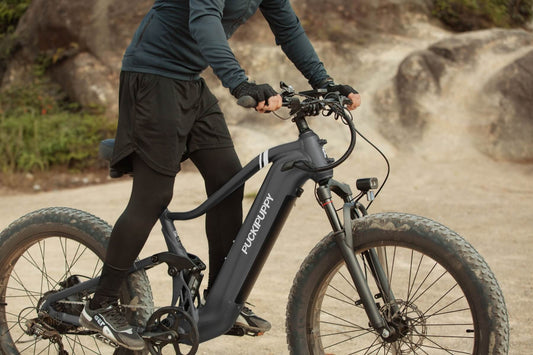
Best Budget Electric Bike 2024
In recent years, electric bikes (e-bikes) have seen a surge in popularity worldwide. These innovative vehicles offer a blend of convenience, eco-friendliness, and accessibility that traditional bicycles sometimes can't match. As more people seek sustainable transportation options and ways to enhance their cycling experience, the demand for electric bikes has risen significantly. Amidst this growing interest, finding the right budget-friendly electric bike can be a daunting task. With numerous options flooding the market, ranging from sleek urban commuters to rugged off-road models, selecting the perfect e-bike depends on various factors such as battery range, motor power, design, and of course, affordability. Additionally, emerging innovations like the Puckipuppy, known for its compact design and robust performance, offer a promising alternative for city commuters and off-roaders seeking both efficiency and style. Let's delve into some key considerations to help you navigate this exciting realm of electric bikes. What Is the Best Affordable Electric Bike? When searching for the best affordable electric bike, it's crucial to consider factors such as price, quality, performance, and user reviews. Key Factors to Consider Battery Life and Range: Ensure the bike can cover your typical commute on a single charge. Motor Power: A higher-wattage motor provides better performance, especially on hills. Weight and Portability: Consider foldable options if you need to carry or store the bike easily. Build Quality: Look for sturdy frames and reliable components. Additional Features: Integrated lights, cargo racks, and suspension can add to the bike’s utility and comfort. Choosing the best affordable electric bike depends on your specific needs, such as commute distance, terrain, and whether you need a foldable option. Let’s take a deep dive into the best budget electric bikes from Puckipuppy. Best Budget Entry-Level Ebike- Samoyed Are you still considering whether to try commuting by an ebike or not? Try the Puckipuppy Samoyed. It’s an ideal choice for ebike beginners as the best budget entry-level ebike. With a powerful motor providing a speed of up to 28 miles per hour, but only priced at $999, it offers people who want to try ebikes the chance without breaking the bank, which makes it truly the best electric bike for the money. “Bike is a blast to ride. Rides comfortably and has a lot of power on tap to assist up hills or when wanting to move quickly.” said one Samoyed customer, “The bike looks gorgeous. Construction is solid, had no concerns about the sturdiness of the bike while riding. Assembly was reasonable, bike came around 85% assembled and clear instructions were provided to finish assembly. For the price point this bike is excellent, I would highly recommend.” 萨摩耶图片 Puckipuppy Samoyed - $999 Motor: 750W Top Speed: 28mph Battery: 48V 15Ah Range: 35-55miles Derailleur: 7-speed Shimano Brake: Mechanical Brakes Payload Capacity: 350lbs Best Budget All-Terrian Ebike- Labrador The Labrador all-terrain e-bike, featuring a robust 750W motor, promises an exhilarating ride with its top speed capability of 28 mph. Designed for adventure seekers and commuters alike, it excels on diverse terrains, from city streets to rugged trails, thanks to its durable construction and reliable performance. With an impressive range of up to 80 miles on a single charge, the Labrador ensures riders can explore further without worrying about battery life. Equipped with fat tires for enhanced traction and stability, along with features like suspension forks for comfort over rough surfaces, this budget-friendly e-bike combines affordability with high-performance features, making it an ideal choice for those seeking an accessible yet thrilling electric biking experience. One Labrador customer wrote: “I was hesitant to order this bike. I just wasn't sure I was ready to make the leap to an e-bike. Don't wait, just get one! It is so much fun, and they are so quiet, I have been able to ride up very close to deer and wild boar without them ever hearing me. You have to get one. So glad I did. I am the envy of our hunting camp.” 拉布拉多图片 Puckipuppy Labrador - $1,299 Motor: 750W Top Speed: 28mph Battery: 48V 20Ah Range: up to 80 miles Derailleur: 7-speed Shimano Brake: Hydraulic Disc Brakes Payload Capacity: 400lbs Best Budget Fat-Tire Ebike- Boxer & Boxer ST The Boxer & Boxer ST fat-tire e-bikes offer an enticing blend of power and versatility, featuring robust 750W motors capable of propelling riders up to 28 mph. Designed for adventurous terrain, these bikes are equipped with 26" x 4" fat tires, providing exceptional grip and stability across various surfaces, from sandy beaches to snowy paths. With an impressive range of up to 80 miles on a single charge, they ensure extended exploration without the need for frequent recharging. The Boxer & Boxer ST models prioritize both comfort and durability, often incorporating features like front suspension forks to smooth out rough rides. Ideal for riders seeking an affordable yet high-performance fat-tire e-bike, the Boxer & Boxer ST deliver an exhilarating experience tailored for off-road enthusiasts and urban commuters alike. One Boxer customer stated: “This is my first ebike purchase and so far I'm loving it. The bike is exactly what I expected. It charges as expected and works wonderfully. Speed is as advertised and even on a low battery it can still produce speeds in excess of 25 MPH on flat roads.” Boxer图片 Puckipuppy Boxer & Boxer ST - $1,299 Tires: 26" x 4" Fat Tire Motor: 750W Top Speed: 28mph Battery: 48V 20Ah Range: up to 80 miles Derailleur: 7-speed Shimano Brake: Hydraulic Disc Brakes Payload Capacity: 400lbs(Boxer) / 350lbs(Boxer ST) Best Value for Money Ebike- Corgi & Corgi2.0 The Corgi and Corgi 2.0 e-bikes are exceptional choices for those seeking the best value for their money, combining affordability with impressive features. Designed with a convenient step-thru frame, these models offer accessibility and ease of use for riders of all ages. With a top speed of 28 mph and a range of up to 80 miles on a single charge, they provide ample power and endurance for both urban commuting and longer recreational rides. The Corgi series prioritizes comfort and reliability, featuring robust construction and ergonomic design elements. Whether navigating city streets or exploring scenic trails, these e-bikes excel with their smooth performance and efficient battery management, making them ideal companions for anyone looking to maximize their biking experience without breaking the bank. “This is my second e-bike.” said one Corgi customer, “Great product, good speed, and very good value. The bike is very nice looking, but most important is the service after the sale. Fantastic! Answered my questions immediately and sent a replacement part fast and working!” 柯基图片 Puckipuppy Corgi & Corgi2.0 - $1,299 Design: Step-Thru Motor: 750W Top Speed: 28mph Battery: 48V 20Ah Range: up to 80 miles Derailleur: 7-speed Shimano Brake: Hydraulic Disc Brakes Payload Capacity: 350lbs Best Budget Folding Cargo Ebike- Husky The Husky folding cargo e-bike stands out as an excellent choice for those seeking practicality and versatility on a budget. Featuring a foldable frame design, it offers convenience for storage and transportation, making it ideal for urban commuters and adventurers with limited space. With its cargo capacity and robust build, the Husky ensures you can transport goods or gear effortlessly. Powered by a 48V 18Ah battery, it provides ample range and reliability, capable of reaching speeds up to 28 mph for swift travel across city streets or suburban paths. This e-bike combines functionality with affordability, making it a standout option for anyone looking to integrate cargo-carrying capability into their daily commute or recreational outings without compromising on performance or cost-effectiveness. One Husky customer commented: “The electric tricycle is great, very nice to ride, lots of space in the back rack, and there is a supermarket not far from my home, so I can go over and buy it anytime in the future without having to carry it around as hard as I used to, and I think I've fallen in love with it!” 哈士奇图片 Puckipuppy Husky - $1,999 Frame Design: Foldable Cargo Capability: Yes Motor: 750W Top Speed: 28mph Battery: 48V 18Ah Range: up to 55 miles Derailleur: 7-speed Shimano Brake: Hydraulic Disc Brakes Payload Capacity: Up to 500lbs Reasons Why The Best Budget Electric Bikes Are Popular The growing interest in budget electric bikes can be attributed to several factors that align with contemporary lifestyle changes, economic considerations, and environmental awareness. Here are some key reasons why more people are seeking the best affordable electric bikes: Affordability Opting for a budget electric bike allows more individuals to access the benefits of electric mobility without breaking the bank. It democratizes the technology, making it accessible to a wider demographic. Value for Money Budget e-bikes often offer a balance between cost and features, providing essential functionalities without unnecessary frills. This ensures you get a reliable and functional bike that meets your needs without overspending. Versatility Many budget electric bikes are designed to be versatile, and suitable for various terrains and purposes. Whether commuting to work, running errands, or enjoying leisurely rides, these bikes offer flexibility in use. Entry-Level Experience For those new to electric bikes, budget options provide a low-risk entry into the e-bike world. They offer a chance to experience the benefits of electric assistance without a significant initial investment. Economic and Environmental Benefits Using a budget e-bike can lead to significant savings compared to traditional vehicles. They are also environmentally friendly, reducing carbon emissions and promoting sustainable transportation alternatives. Health and Fitness Contrary to popular belief, e-bikes still offer health benefits. Riders can choose their level of assistance, gradually increasing physical activity as they feel comfortable. Budget e-bikes encourage more people to incorporate cycling into their daily routines, improving fitness and well-being. At Last As the popularity of electric bikes continues to soar, their appeal lies not only in convenience and eco-friendliness but also in their affordability and versatility. From sleek urban commuters to rugged all-terrain models, each Puckipuppy ebike model offers a unique blend of features like powerful motors, impressive range, and ergonomic designs. For people who commute with ebikes more, Samoyed and Corgi would be a great choice. For people who enjoy off-road excitement more, Labrador, Boxer and Boxer ST would be a good fit. For people who value convenience and cargo capacity more, the Husky is undoubtedly a choice. Explore more about our ebikes and take a look at the latest deals.
Best Budget Electric Bike 2024
In recent years, electric bikes (e-bikes) have seen a surge in popularity worldwide. These innovative vehicles offer a blend of convenience, eco-friendliness, and accessibility that traditional bicycles sometimes can't match. As more people seek sustainable transportation options and ways to enhance their cycling experience, the demand for electric bikes has risen significantly. Amidst this growing interest, finding the right budget-friendly electric bike can be a daunting task. With numerous options flooding the market, ranging from sleek urban commuters to rugged off-road models, selecting the perfect e-bike depends on various factors such as battery range, motor power, design, and of course, affordability. Additionally, emerging innovations like the Puckipuppy, known for its compact design and robust performance, offer a promising alternative for city commuters and off-roaders seeking both efficiency and style. Let's delve into some key considerations to help you navigate this exciting realm of electric bikes. What Is the Best Affordable Electric Bike? When searching for the best affordable electric bike, it's crucial to consider factors such as price, quality, performance, and user reviews. Key Factors to Consider Battery Life and Range: Ensure the bike can cover your typical commute on a single charge. Motor Power: A higher-wattage motor provides better performance, especially on hills. Weight and Portability: Consider foldable options if you need to carry or store the bike easily. Build Quality: Look for sturdy frames and reliable components. Additional Features: Integrated lights, cargo racks, and suspension can add to the bike’s utility and comfort. Choosing the best affordable electric bike depends on your specific needs, such as commute distance, terrain, and whether you need a foldable option. Let’s take a deep dive into the best budget electric bikes from Puckipuppy. Best Budget Entry-Level Ebike- Samoyed Are you still considering whether to try commuting by an ebike or not? Try the Puckipuppy Samoyed. It’s an ideal choice for ebike beginners as the best budget entry-level ebike. With a powerful motor providing a speed of up to 28 miles per hour, but only priced at $999, it offers people who want to try ebikes the chance without breaking the bank, which makes it truly the best electric bike for the money. “Bike is a blast to ride. Rides comfortably and has a lot of power on tap to assist up hills or when wanting to move quickly.” said one Samoyed customer, “The bike looks gorgeous. Construction is solid, had no concerns about the sturdiness of the bike while riding. Assembly was reasonable, bike came around 85% assembled and clear instructions were provided to finish assembly. For the price point this bike is excellent, I would highly recommend.” 萨摩耶图片 Puckipuppy Samoyed - $999 Motor: 750W Top Speed: 28mph Battery: 48V 15Ah Range: 35-55miles Derailleur: 7-speed Shimano Brake: Mechanical Brakes Payload Capacity: 350lbs Best Budget All-Terrian Ebike- Labrador The Labrador all-terrain e-bike, featuring a robust 750W motor, promises an exhilarating ride with its top speed capability of 28 mph. Designed for adventure seekers and commuters alike, it excels on diverse terrains, from city streets to rugged trails, thanks to its durable construction and reliable performance. With an impressive range of up to 80 miles on a single charge, the Labrador ensures riders can explore further without worrying about battery life. Equipped with fat tires for enhanced traction and stability, along with features like suspension forks for comfort over rough surfaces, this budget-friendly e-bike combines affordability with high-performance features, making it an ideal choice for those seeking an accessible yet thrilling electric biking experience. One Labrador customer wrote: “I was hesitant to order this bike. I just wasn't sure I was ready to make the leap to an e-bike. Don't wait, just get one! It is so much fun, and they are so quiet, I have been able to ride up very close to deer and wild boar without them ever hearing me. You have to get one. So glad I did. I am the envy of our hunting camp.” 拉布拉多图片 Puckipuppy Labrador - $1,299 Motor: 750W Top Speed: 28mph Battery: 48V 20Ah Range: up to 80 miles Derailleur: 7-speed Shimano Brake: Hydraulic Disc Brakes Payload Capacity: 400lbs Best Budget Fat-Tire Ebike- Boxer & Boxer ST The Boxer & Boxer ST fat-tire e-bikes offer an enticing blend of power and versatility, featuring robust 750W motors capable of propelling riders up to 28 mph. Designed for adventurous terrain, these bikes are equipped with 26" x 4" fat tires, providing exceptional grip and stability across various surfaces, from sandy beaches to snowy paths. With an impressive range of up to 80 miles on a single charge, they ensure extended exploration without the need for frequent recharging. The Boxer & Boxer ST models prioritize both comfort and durability, often incorporating features like front suspension forks to smooth out rough rides. Ideal for riders seeking an affordable yet high-performance fat-tire e-bike, the Boxer & Boxer ST deliver an exhilarating experience tailored for off-road enthusiasts and urban commuters alike. One Boxer customer stated: “This is my first ebike purchase and so far I'm loving it. The bike is exactly what I expected. It charges as expected and works wonderfully. Speed is as advertised and even on a low battery it can still produce speeds in excess of 25 MPH on flat roads.” Boxer图片 Puckipuppy Boxer & Boxer ST - $1,299 Tires: 26" x 4" Fat Tire Motor: 750W Top Speed: 28mph Battery: 48V 20Ah Range: up to 80 miles Derailleur: 7-speed Shimano Brake: Hydraulic Disc Brakes Payload Capacity: 400lbs(Boxer) / 350lbs(Boxer ST) Best Value for Money Ebike- Corgi & Corgi2.0 The Corgi and Corgi 2.0 e-bikes are exceptional choices for those seeking the best value for their money, combining affordability with impressive features. Designed with a convenient step-thru frame, these models offer accessibility and ease of use for riders of all ages. With a top speed of 28 mph and a range of up to 80 miles on a single charge, they provide ample power and endurance for both urban commuting and longer recreational rides. The Corgi series prioritizes comfort and reliability, featuring robust construction and ergonomic design elements. Whether navigating city streets or exploring scenic trails, these e-bikes excel with their smooth performance and efficient battery management, making them ideal companions for anyone looking to maximize their biking experience without breaking the bank. “This is my second e-bike.” said one Corgi customer, “Great product, good speed, and very good value. The bike is very nice looking, but most important is the service after the sale. Fantastic! Answered my questions immediately and sent a replacement part fast and working!” 柯基图片 Puckipuppy Corgi & Corgi2.0 - $1,299 Design: Step-Thru Motor: 750W Top Speed: 28mph Battery: 48V 20Ah Range: up to 80 miles Derailleur: 7-speed Shimano Brake: Hydraulic Disc Brakes Payload Capacity: 350lbs Best Budget Folding Cargo Ebike- Husky The Husky folding cargo e-bike stands out as an excellent choice for those seeking practicality and versatility on a budget. Featuring a foldable frame design, it offers convenience for storage and transportation, making it ideal for urban commuters and adventurers with limited space. With its cargo capacity and robust build, the Husky ensures you can transport goods or gear effortlessly. Powered by a 48V 18Ah battery, it provides ample range and reliability, capable of reaching speeds up to 28 mph for swift travel across city streets or suburban paths. This e-bike combines functionality with affordability, making it a standout option for anyone looking to integrate cargo-carrying capability into their daily commute or recreational outings without compromising on performance or cost-effectiveness. One Husky customer commented: “The electric tricycle is great, very nice to ride, lots of space in the back rack, and there is a supermarket not far from my home, so I can go over and buy it anytime in the future without having to carry it around as hard as I used to, and I think I've fallen in love with it!” 哈士奇图片 Puckipuppy Husky - $1,999 Frame Design: Foldable Cargo Capability: Yes Motor: 750W Top Speed: 28mph Battery: 48V 18Ah Range: up to 55 miles Derailleur: 7-speed Shimano Brake: Hydraulic Disc Brakes Payload Capacity: Up to 500lbs Reasons Why The Best Budget Electric Bikes Are Popular The growing interest in budget electric bikes can be attributed to several factors that align with contemporary lifestyle changes, economic considerations, and environmental awareness. Here are some key reasons why more people are seeking the best affordable electric bikes: Affordability Opting for a budget electric bike allows more individuals to access the benefits of electric mobility without breaking the bank. It democratizes the technology, making it accessible to a wider demographic. Value for Money Budget e-bikes often offer a balance between cost and features, providing essential functionalities without unnecessary frills. This ensures you get a reliable and functional bike that meets your needs without overspending. Versatility Many budget electric bikes are designed to be versatile, and suitable for various terrains and purposes. Whether commuting to work, running errands, or enjoying leisurely rides, these bikes offer flexibility in use. Entry-Level Experience For those new to electric bikes, budget options provide a low-risk entry into the e-bike world. They offer a chance to experience the benefits of electric assistance without a significant initial investment. Economic and Environmental Benefits Using a budget e-bike can lead to significant savings compared to traditional vehicles. They are also environmentally friendly, reducing carbon emissions and promoting sustainable transportation alternatives. Health and Fitness Contrary to popular belief, e-bikes still offer health benefits. Riders can choose their level of assistance, gradually increasing physical activity as they feel comfortable. Budget e-bikes encourage more people to incorporate cycling into their daily routines, improving fitness and well-being. At Last As the popularity of electric bikes continues to soar, their appeal lies not only in convenience and eco-friendliness but also in their affordability and versatility. From sleek urban commuters to rugged all-terrain models, each Puckipuppy ebike model offers a unique blend of features like powerful motors, impressive range, and ergonomic designs. For people who commute with ebikes more, Samoyed and Corgi would be a great choice. For people who enjoy off-road excitement more, Labrador, Boxer and Boxer ST would be a good fit. For people who value convenience and cargo capacity more, the Husky is undoubtedly a choice. Explore more about our ebikes and take a look at the latest deals.


















